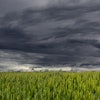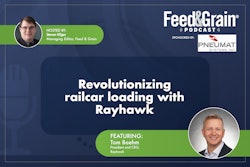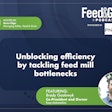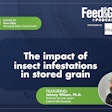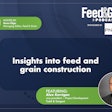
In the latest episode of the Feed & Grain Podcast, Steven Kilger and Joe Mlynek from Safety Made Simple discuss the critical issue of heat illness prevention during the summer. They cover the dangers of working in high temperatures, necessary precautions for employees and companies, and strategies to ensure everyone stays safe. Listen to the episode for valuable insights on protecting workers in extreme heat.
Transcript has been edited for clarity.
Steven Kilger (00:03):
Hi everyone, my name is Steven Kilger and I'm the managing editor of Feed & Grain magazine and host of the Feed & Grain Podcast. Thank you so much for joining me today as we dive deep into the issues affecting feed manufacturing, grain handling, and allied industries.
Today's episode is brought to you by the BinWhip from Pneumat Systems. The powerful tool impact BinWhip removes the toughest buildup and blockages in industrial storage silos without hazardous silo entry. Learn more today at binwhip.com.
In today's episode, my guest Joe Mlynek, content creation expert and partner at Safety Made Simple, is here to discuss a critical topic, especially with the summer in the United States, heat illness prevention. We discuss the dangers of working in hot conditions, what employees and companies should do when it's hot out, and of course, tips to make sure everyone goes home safe at the end of the day.
I hope you enjoy the interview. If you want to help with the podcast and are listening to this in a podcasting app, please rate us and subscribe. If you're listening online, sign up for the Feed & Grain newsletter — Industry Watch, to see the newest podcasts drop and stay up to date with all the latest news from around the industry.
Thank you so much for listening and onto the show.
Hi Joe, thanks for coming on the podcast.
Joe Mlynek (01:16):
Thank you very much, I appreciate the opportunity. As mentioned, I think this is the third time I've been on with you, I always enjoy the conversation.
Kilger (01:24):
Yeah, you're one of our favorites. It's always really nice to have you on. Well, we were talking a little beforehand. You're so knowledgeable about all this stuff and Safety Made Simple does such a great job with your programs. It's always kind of nice to be able to give people a solution to the problem we're talking about.
Can you tell us for people who might not have listened to your previous episodes, can you tell us a little bit about yourself, a little bit about Safety Made Simple and its mission, and what it does?
Mlynek (01:48):
Sure, I started my career in safety in 1996. I started in the auto industry which is not even close to the ag world. Shortly afterward I worked in the auto industry for three years. I worked for a large agribusiness company for 10 years in corporate safety and I learned much of what I know about particularly the grain and feed industry from working at that company.
In 2009, I decided to try my hand at consulting. So, I started Progressive Safety Services and primarily what we provide is program development, training, inspections, and those types of services. I spend about, I don't know, nowadays maybe 30-40% of my time doing that and the rest at Safety Made Simple. I joined Safety Made Simple in 2014. Chuck Pirie, the founder, and I ran across each other while we were doing some consulting.
He's a safety professional as well. And he said, you know, I'd be interested in having you develop some online training courses. We feel there's some real opportunity in the Ag sector, particularly with grain. And I said, well, that's right up my alley. So, we started to develop courses in 2014, focusing on grain and we've expanded there. I became a part of Safety Made Simple in 2017. We are an online training provider in the Ag industry. We focus primarily on Ag-specific content.
We've been serving the ag industry for a little over 10 years. We've got about 165 courses, a lot of different areas, you know, ag safety including grain, livestock, cattle feeding, general safety, construction safety, DOT, driver safety, and food safety. We get into equipment maintenance and human resources as well and I might have forgotten a few things We work a lot with grain elevators, co-ops, private grain companies, agronomy centers, and big in the cattle feeding industry. We've got partners that are flour mills, feed mills, and biofuel facilities. Even construction companies as well.
So we offer our courses within our learning management system at Safety Made Simple, but also many of our partners have their learning management system so they can, we can kind of plug-in our courses in an existing learning management system maybe that they already have.
As far as our mission, it's pretty simple just like our name. Most of the people that I work with, particularly on the content side of building courses, are safety professionals.
And myself and Chuck Piri, my partner, being both safety professionals, I understand the impact that serious injuries and even fatalities can have on people, families, communities, companies, and our mission is to send people home safely, just pure and simple.
Kilger (04:46):
Well yeah, I mean it's hard when you see those stories out there and things it always seem like a statistic until it happens at your facility and you have to have that conversation with someone's family then it becomes a very different thing.
Mlynek (05:01):
Yeah, it's interesting, Steve, because when you mention statistics, we often look at these numbers and don't realize that there's a person, that number represents a person.
And in some instances, you know, I'm going to be at Convey in July to talk about a fatality during my career and to see that number reported from OSHA, how many fatalities were that year, and I knew that I knew one of them. Personally and a lot of times we look at these numbers and that escapes us that there's a there's a person behind that.
Kilger (05:35):
And I always feel that as a person deals with this news on a daily I mean it's my job right to find out and report on this stuff and in a way you have to kind of take yourself out of it but still you look at some of these stories and it's a tragedy every time. Well, what we have you here for today though is hot.
I don't know about what it's like where you are but here in southern Wisconsin it has been a scorcher of a summer so far and we thought it would be a good time to kind of talk about extreme heat. How can it impact the workplace? How to keep everyone safe when it's hot out? Best practices and what you can kind of do with that sort of thing.
Can you explain a little bit about just what extreme heat can do to productivity, efficiency, and of course some of the dangers behind Yeah, you know, it's interesting.
Mlynek (06:29):
That's a question that I don't think we draw a parallel with heat safety as the productivity piece. The name of the meeting Move slower, things take longer, but it beats the alternative. And the alternative is you have somebody that has a heat illness, which can include something like a heat stroke.
I worked for a grain company years ago as a consultant and they had a contractor that died of heat stroke after a long hot day in Louisiana. And that's the alternative. So, you know, we're going to talk about prevention strategies today and that's important.
But on the productivity side, this loss of efficiency and productivity, there are studies out there that indicate that this will cost U.S. businesses $100 billion annually and they expect that to increase two to threefold over the next five to ten years. When you think about productivity, like, well, how does it affect, well, obviously we're working It takes a little bit longer, that kind of thing. But I had a client in a southern climate. It's probably been a year or two and I was inspecting the facility. Brand new employee. I usually start at the top of the Grand Elevator and work my way down. It's just kind of the way I do it.
When I got down into the tunnels, a guy was working down there.
And he was a new employee I think maybe his first week on a job maybe even the first couple days. It's warm down there but not as warm as it is outside. I would usually I would think hey you know you want guys cleaning basement tunnels in hot weather it's probably the coolest place in the facility. He was working pretty hard I could tell that I didn't see anything abnormal.
About two hours later as I'm walking to the office to just finish up he's on his back with a bunch of employees around him they've called 911. He's in pretty bad shape, almost like he turned white, almost having difficulty breathing, he's panicking a little bit, and we're trying to cool him down, you know, those guys are getting him wet towels and all that kind of thing, and he's, you know, they come and take him to the hospital, he ends up being okay, he's got heat exhaustion.
But you think about that, I mean now you have one employee that was sent to the hospital, you have a lot of them that they kind of took a They had another subsequent meeting to talk about the importance of hydrating and taking breaks and all those types of things. And on top of it, they're down a worker for a few days. So you can easily see why that would affect productivity at a facility level.
Kilger (09:12):
Yeah. And as someone who's gotten sick from the heat before, it sneaks up on you. Suddenly you're like, I'm hot, I'm uncomfortable, I'm uncomfortable. And then suddenly you're there. So, you mentioned heat stroke, are there any other kind of health risks that employees might face when exposed to high temperatures? In my mind, I think of, even if it's not heat related, just the fact working in hot conditions makes you distracted. I would imagine you would just not, it's so hard to be fully focused on your job when you are warm and you are uncomfortable.
Mlynek (09:45):
Yeah, it's funny you say that. Even as a safety person that does a lot of inspections out in the field, I'll tell you when it's super cold and it's super hot, I'm probably not as effective as when I'm comfortable. And it's just reality. So when you think about there are four main types of heat illnesses out there. Heat cramps are one of them. If you've ever played athletics or anything like that, Hot summer days, athletes, that kind of thing. I used to have a problem when I was in high school.
I'd cramp up in the legs, that kind of stuff, in the summer during two days of football, that kind of stuff. Wasn't adequately hydrated at the time. It was extremely hot back then in the late 80s and early 90s. We just powered through all this stuff. Not as knowledgeable as we are today about some of these illnesses. So you got heat cramps, you know, there's heat rash and that's just generally triggered by sweating, excessive sweat.
We were having a meeting so we took the whole team out to the game and it's 98 degrees with you know 80-90% humidity and here's a guy from up north you know we just don't get that warm occasionally and I'm down there and they seem to be doing okay and I am sweating like crazy and I'm drinking water and I remember on the ride home I'm like man I have a headache so I got back to the room kind of rehydrated rested a little bit cool down ended up being okay but Those are the things that can spiral out of control if you don't catch them or understand what the symptoms are.
We have heat exhaustion and the one that we are most concerned about the most serious thing is heat stroke that can kill you. And that's really when your body can't regulate temperature anymore. You stop sweating and your body will reach above your temp around 104 or more. That's when that body doesn't, it just kind of almost freezes, doesn't sweat, doesn't address it. And that can be dangerous and that can kill people.
Kilger (11:58):
You say being from the north, I feel you completely because when I visit down there in the south during the summer, you visit a feed mill or a grain elevator or something, and you go there and you talk to them and they're fine walking around but there's me just getting ready to die in my button-up shirt.
Mlynek (12:15):
Yeah, and it's interesting, Steve, too, that just humidity impacts Two years ago I had back-to-back consulting weeks. I was in Dallas-Fort Worth one week and it was July and it was 90-some degrees I don't know the humidity is like 80-90%. I mean you walk out to your car at 6 a.m. and you're like being from Ohio I'm like whoa man this is crazy.
It was a tough day and then the next week I'm up in Idaho and I fly into Boise and I'm working up there in that area and you got a hundred-degree day but you have no humidity. You still have to make sure you're hydrating. You don't sweat, it just evaporates so quickly. But it almost feels so much more comfortable. But it's still hot and you kind of forget about it. You dry up very quickly. I noticed that when I was there.
Kilger (13:05):
Well, especially if there's like a certain mode where you start to get sick and the last thing you want to do is put something into your body. No, that's the time you need to be hydrating. Are there any specific signs or symptoms that people can be on the lookout for? You know, you're working with a guy, you see him doing these things and then maybe you can be like, hey, let's take a break. Before things get too far.
Mlynek (13:27):
Any of the audience ever has listened to the webinars that I've provided for maybe like a Grain Journal or NGFA. One of the things that I like to focus on is that it's important, we did a webinar with NGFA last week where we talked about hazardous atmosphere.
And like heat illnesses, I think it's important for employees to understand what these symptoms are because then they can identify them in themselves and others.
Just like when I went to the Royals game, I knew that the headache was due to probably dehydration and heat exhaustion. So I knew to drink water and get in a cool spot and rest for a while and I was fine. So if you can recognize those types of things in yourself and others, you can do something about it. So when you look at those symptoms, obviously things like heat cramps, that's a symptom, right?
Heat rash, that's a symptom. Heat exhaustion can be a headache or nausea, people will get dizzy, and they'll be sweating heavily like I was at the Royals game. Extreme thirst, just you can't drink enough water. The serious one, as I mentioned earlier, is heat stroke, you'll start to see people, they'll become confused, some of them will lose consciousness, seizures, and those are violent reactions.
And you'll also see that they're so warm, like I mentioned earlier, that they'll stop sweating. Working at a grain elevator or feed facility. As I mentioned earlier, it's not just workers outside. This can happen inside. You know, the example I used was a guy working in a tunnel where I thought, like, that's not the hottest of places, probably a decent place to be working during the day, but he still had heat exhaustion.
Kilger (15:15):
Yeah, well, we can forget, like, how stuffy and humid it can get inside, right?
Mlynek (15:19):
Like, it's just... Yeah, the airflow and that kind of thing.
Kilger (15:24):
Seems so important. Well, I mean, we should all be looking out for our co-workers and each other and ourselves. And heat illness and things seem like it kind of catches. Well, like you said earlier, people want to power through it, right? It's kind of still thought in that category of like, oh, don't be like a weird, weak guy who can't work in 94-degree weather in the humidity. So there's still kind of that stigma behind it, which is dangerous when something can kill you if you don't address it right away.
Mlynek (15:55):
Exactly, I work in an industry that's how it's called like can do, will do kind of thing.
We were pretty tough and sometimes I think taking a break is looked at weakness and all that. I think we need to get past that point of it and I think we're moving in that direction.
Kilger (16:11):
Yeah, especially if you're in, I mean, we work in a high, well, I don't, the people we talk to every day, we work in a very high stakes, high-pressure thing where stuff's moving fast and when you need to get stuff done, it needs to get done quickly. You know, you need to get that train, you need to get that truck unloaded, you need to get that batch made. So yeah, it can be hard to kind of take that break. Are there things that employers can do, effective strategies that they can do to kind of keep their workers safe and healthy during this?
Mlynek (16:42):
Yeah, there are a lot of things they can do. I'm happy to report that I've seen them doing this and taking this seriously. And there's been a lot of efforts, particularly through NGFA, to promote having a heat illness prevention program and those types of things.
So having a written program around this and OSHA has a national emphasis program on heat illnesses and so they're stopping at work sites when it's hot out and checking to see if there's water and just having a plan right up front. There are some states like California and there are some other state plan states that run their own OSHA that require this. So I just think having a plan like what's the trigger? It feels like a temperature of 80 degrees or whatever it might be and then what are we going to do if it gets to an extreme 90 plus?
What are we going to do at that point? So it's having that program in place.
And just the other piece is monitoring the temperature and the weather and the employees as well. So I was just knowing I was going to come on and talk to you today, Steve. I was, I have the app on my phone, but I haven't used it lately. There's an OSHA heat safety tool app that gives you the feel-like temperature in your area. It asks for permission to kind of track where you're at and know your location.
And you can pull that up and it'll tell you whether or not the feels-like temperature is. So anything above 80 now is considered something where some action should be taken. So that just calculates the heat index and the heat x is the I think as an employer, at the very least, if you just follow the tenet of water rush aid, if you don't have a formal program, that that's an important thing to do. But there are several other strategies people can use, so all new and existing employees should be able to acclimate to weather changes like that.
And you think about like, so new employees, maybe they came from, they're not working in an industry They worked in an air-conditioned environment like you and I do on a lot of days. We're fortunate, right? They came from that and now they're working out in this facility and it's 90-plus degrees with really high humidity. That's a shock to the system.
So how do we slowly introduce them into the workplace? You talk about existing employees, so being located in Ohio, our Junes are usually, we're 78 degrees, 80 degrees. We're 90, 95, and close to 100 most of the week with pretty high humidity. That's a drastic change for any, even the people who work outside. I talked to some construction guys and they're like, yeah, you know, this was a lot different than what we saw two weeks ago. We had our furnaces on when we woke up in the morning, that kind of thing.
Mlynek (19:16):
So really just being able to acclimate to the heat, I think the postponing non-essential outdoor work, if you can do that to reduce the times when the heat index is a little bit lower, scheduling Physically demanding stuff for cooler periods of the day.
Can we do that early in the morning or evening if we're working in the evening, that kind of thing? The additional breaks on days when there's a high heat index.
Most facilities now I think have air-conditioned places where people can rest, that kind of thing. Another one that people, sometimes I don't know if they think about, but the use of like the buddy system, avoid working alone. That's important anytime you're working in a hazardous environment. If I were working at heights, I wouldn't want to work alone in case I fell, that I'm hanging from a harness, somebody needs to be able to get help to me, right, or help me rescue, you know, that piece of it.
So, I think not working alone, having a buddy system, or at the very least if that's not feasible, making sure everybody has a radio and we just check on them now and then.
Kilger (20:16):
Yeah because like we said like it's very hard when you're in the moment when you're suffering from well especially heat strokes you're delirious at that point there's something you can't make rational decisions to save yourself having that other person there it's extremely important.
Mlynek (20:32):
Yeah, the employee that I was talking about earlier, the example, was working with somebody else and they helped him get up to the work floor and get help from there. So he was lucky. I mean, if that gets worse, we don't know if he loses consciousness or something and how long he's going to be in that location without anybody even checking him. So I think that's important. The other piece is hydration. So I think it's important as well. They can only absorb it so fast.
Mlynek (21:21):
Exactly. And then too much water at times isn't good either. So, water is the best thing. Sports drinks aren't bad because they do replace electrolytes or salts.
But, you know, I get into notifications that I'm seeing guys chugging all these energy drinks and stuff with caffeine. Just like alcohol outside of work, those are diuretics. So, you're going to be shedding water rather than keeping it in your body.
It's just important to make sure, I think as well, the other thing we forget is that when we get home at night, hydrate at night to get ready for the next day. And then, you know, the last thing Steve ought to say is just, you know, get trained workers. That's important so that they understand like we talked about these symptoms and then these strategies, you know, what can you do to help yourself throughout the day.
Kilger (22:05):
Well, and it's been longer, harder routes for a while now. Every summer seems to be the hottest one on record, so it's going to be more and more common. So best time to figure this out is now. Speaking of getting some training in and stuff, it's something Safety Made Simple can help with, with your online courses. What specific kind of topics do you think might be good for management facilities who are thinking about getting some training for their employees for heat readiness?
Mlynek (22:35):
We offer a couple of courses, but one specifically on heat illness prevention. I was the subject matter expert for it. When I put it together, I think the course is probably about two years old, I looked at California because they have a heat illness prevention standard there and they're the strictest. I expect when the federal OSHA at some point here is going to release a heat illness prevention standard, I think that's, in my opinion, that's going to happen, that it's going to be based on that California standard.
So, when I looked at the California standard, I focused on, okay, what are the training requirements? What do they want employees to know? And really what it got into was, and we put the course together, they want them to recognize the warning signs and symptoms, the stuff that we talked about today, the types of heat illnesses, What employees can do in the event of an emergency and we also in our course we cover probably a little over.
10 or more strategies of what not only employees can do but if you're a supervisor and a manager and that's kind of what our program focuses on is the the prevention piece but we also touch on if you witness something or somebody with a heat illness what do you do in each one of those situations.
Our course is available in Spanish because we do have our partners, particularly in the southern states, have a lot of Spanish-speaking workers, but we include testing and those types of things as well.
Kilger (24:04):
Yeah, plus you guys do, I mean, you do courses on so many different topics. Like you said, you're up to 160 now. You're adding new ones all the time. Is anything else exciting that people might want to take a look at?
Mlynek (24:14):
We add a new course every month and we also update an existing course when we update a course that's existing, it's An entirely new course, it's not just going in and changing a couple of pictures or the animations we use or interactivity, it's completely different. We've got a lot of good ones coming up.
I will tell you that the one we've been given a lot of interest in, just a couple of months ago, we released a course on OSHA's grain handling standard and I was a subject matter expert on that one as well. And we were focused on the performance goals within the grain handling standard from OSHA.
What I find as a consultant is, and I don't expect supervisors or managers to read the grand handling standard and all those types of things, but I think they need to understand that there are some requirements out there from the federal government or even the state. And they also a lot of times will correspond with their company's requirements. So they say, oh, okay That's why we have to do that and that's why we do that. So we did a nice course. Again, they're 20 minutes long. That gives a nice overview of all the OSHA requirements for the grain handling standard.
Kilger (25:19):
Yeah, well, that's amazing. I encourage everyone to check it out. There'll be a link to Safety Made Simple's website down in the description of this and on the website and the transcript and everything like that. But thank you so much for coming to talk to me today, Joe.
Mlynek (25:35):
Thank you, Steve, appreciate the opportunity.
Kilger (25:38):
Of course, we'll have to have you on again. Harvest is coming up, so it'll be time to review some safety tips then. All right, awesome. Well, until next time everyone stays safe out there.
.jpg?auto=format%2Ccompress&crop=faces&fit=crop&h=48&q=70&w=48)

